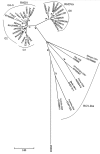Variant rabbit hemorrhagic disease virus in young rabbits, Spain
- PMID: 23171812
- PMCID: PMC3557890
- DOI: 10.3201/eid1812.120341
Variant rabbit hemorrhagic disease virus in young rabbits, Spain
Abstract
Outbreaks of rabbit hemorrhagic disease have occurred recently in young rabbits on farms on the Iberian Peninsula where rabbits were previously vaccinated. Investigation identified a rabbit hemorrhagic disease virus variant genetically related to apathogenic rabbit caliciviruses. Improved antivirus strategies are needed to slow the spread of this pathogen.
Figures


References
-
- World Organisation for Animal Health. Terrestrial manual. Chapter 2.6.2. Rabbit haemorrhagic disease. 2010. [cited 2012 Feb 27]. http://www.oie.int/fileadmin/Home/eng/Health_standards/tahm/2.06.02_RHD.pdf
Publication types
MeSH terms
Substances
Associated data
- Actions
LinkOut - more resources
Full Text Sources
Other Literature Sources
